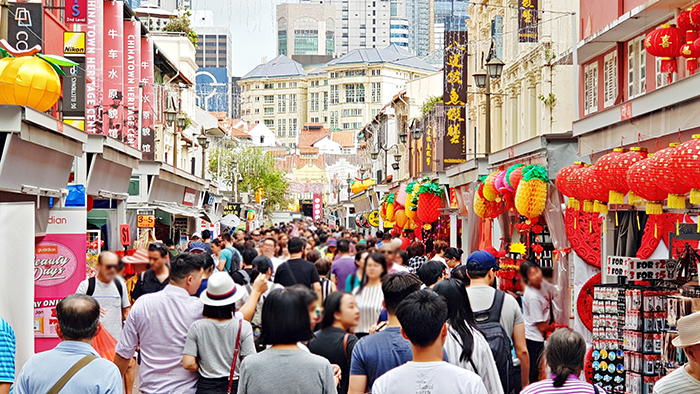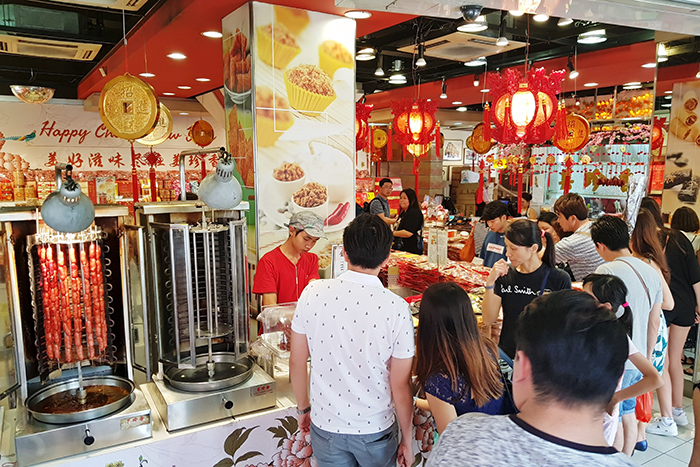View this article in another language
- 한국어
- English
- 日本語
- 中文
- العربية
- Español
- Français
- Deutsch
- Pусский
- Tiếng Việt
- Indonesian

Chinatown in Singapore is filled with an infectiously joyous atmosphere during the (Chinese) Lunar New Year holiday.
By Korea.net Honorary Reporter Vera Lee from Singapore
Photos∙video = Vera Lee
Like in Korea, Lunar (Chinese) New Year in Singapore is considered a major holiday. Koreans usually visit their hometowns to see family, perform ancestral rites, eat tteokguk (sliced rice cake soup) and wear beautiful Hanbok (traditional Korean attire). Children receive money from their elders after performing sebae (bowing).
Though not exactly the same, the ways the holiday is celebrated in both countries share similarities.
Legend of Chinese New Year
An ancient Chinese legend says the color red was used to frighten away Nian (年), a beast that was thought to live on a mountain and come down on the first day of every new year to terrorize neighboring villagers. This creature supposedly feared red and loud noises, so Chinese would wear red as a tradition to scare away evil spirits and bad luck on Chinese New Year. In the past, people used to light firecrackers that exploded with a loud crackling noise in the belief that the practice ward off evil spirits. Though Singapore has banned fireworks for safety reasons, residents of the city-state consider Lunar New Year the year's biggest holiday. People also wear new clothing from head to toe to symbolize a new beginning for a new year.
The following are unique events that occur in Singapore around Chinese New Year.
Huge crowds in Chinatown
Streets in Chinatown are lit with red lanterns and jam-packed with street vendors selling everything from festive goodies, plants, traditional cheongsam dresses and New Year's decorations. This is undoubtedly a must-visit place for Chinese to shop, even if it means jostling with a sea of people.
The lines can stretch for blocks and blocks, especially at:
- Renowned 肉干 or bakkwa (Chinese pork jerky) stores like Lim Chee Guan and Bee Cheng Hiang
- Banks and special pop-up ATMs to withdraw new and crispy banknotes
- "Lucky" branches of Singapore Pools offering a grand prize of millions of Singaporean dollars

People line up for deep red slices of bakkwa (Chinese pork jerky). Eating this is believed to attract good luck in the new year.
Singaporeans during Chinese New Year also perform the following customs.
Spring cleaning
Cleaning every inch of a home is the best way to welcome the new year. Removing all the dust and old broken things in a home is believed to ward off bad luck. This could result in Caishen, the Chinese god of wealth, visiting one's sparklingly clean house and bringing a windfall to the tenant family.
Family reunion dinner
The family reunion dinner, or tuan yuan (团圆), is a festive event used by people to bond with immediate family on the eve of Chinese New Year.
In addition, Singapore, as well as neighbouring countries Malaysia and Indonesia, have the unique custom of tossing yu sheng (鱼生), also known as the prosperity toss. This practice usually involves shredded vegetables such as white radish, carrot, cucumber, pomelo, red pickled ginger and orange peel served on a big plate.
The climax begins when the ingredients are thrown up into the air. Enthusiastic diners will use their chopsticks to toss the ingredients as high as possible while loudly shouting "Lo hei!" (撈起, Scoop it up!), "Huat ah!" (发啊, Prosper!) and other auspicious phrases to wish for good fortune, prosperity and health in the new year. The higher one tosses the ingredients, the more luck is attracted.
Shou Sui (守岁, guarding age)
A custom on Chinese New Year is for family members to stay up late to usher in the new year. This practice is considered a prayer for parents to live a long life, as the longer their children stay awake, the longer their parents will live. In return, parents give hongbao (red envelopes) containing money called yā suì qián (压岁钱 = age-suppressing money) in the belief that their children will all reach age 100.
Hongbao
On the first day of Lunar New Year, everyone gets dressed in new clothes that are preferably colored red or the traditional Chinese dress cheongsam, or qipao (旗袍) in Mandarin. "Gong xi fa cai" (恭喜发财 May you enjoy greater wealth), "Wan shi ru yi" (万事如意 All will occur as you desire) and "Nian nian you yu" (年年有余 May every year end with a sufficient surplus) are among common greetings one hears when meeting people, especially the elderly. Children and young singles will receive red envelopes as a token of blessing and good fortune.
Tips: Children are encouraged to memorize and recite more phrases to get bigger hongbao.
Mandarin Oranges
Visiting family and relatives are usually accompanied by exchanging pairs of Mandarin oranges. This is because the Cantonese pronunciation of giving the fruit, song gam, sounds similar to the expression "giving gold," and the Chinese word for orange sounds like "luck" and "wealth," signifying wishes for prosperity.
Lion Dance
The lion dance is performed by two dancers in a lion's suit and accompanied by drummers and sometimes a person dressed as a Buddhist monk. Usually performed during Chinese New Year, this dance symbolizes good luck, as the lion is believed to be an auspicious animal, and wishes for a stable and prosperous year.
The lion performs the dance, eats lettuce and then spits it back to the audience to give them luck and prosperity because cái (採) meaning "vegetable" sounds similar to cái (财) meaning "fortune." Then the performers arrange a good luck design from the oranges and a set of lucky numbers at the end of the dance.
wisdom117@korea.kr
* This article is written by a Korea.net Honorary Reporter. Our group of Honorary Reporters are from all around the world, and they share with Korea.net their love and passion for all things Korean.